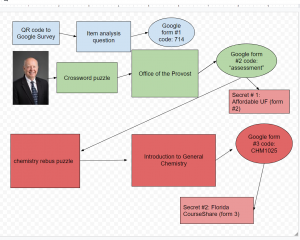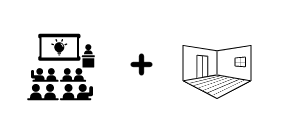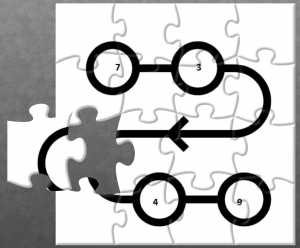Learning Activities
25 Digital “Escape Box” Puzzles
Micah Jenkins
Digital “Escape Boxes” | Puzzles | Locks | Production | Activity Launch | References
Digital “Escape Boxes”
In both digital and traditional escape boxes, the goal for participants is the same: Use a series of clues to solve puzzles for codes that unlock “secrets,” the information that is hidden behind locks. Digital and traditional escape boxes both offer the same benefits to students: In both cases, the activity offers a fun way to foster teamwork, and encourages critical thinking and problem solving skills all while supporting your learning goals. Digital escape boxes, however, have some additional benefits:
- work well for limited or $0 budgets
- don’t need to be reassembled before they can be used again
- don’t have to be transported from place to place
- can be used in large enrollment courses
Considerations
Digital and physical escape boxes have some things in common that you should consider when planning:
- Thought. Take time to consider how the clues and puzzles you create support your learning goals.
- Quantity. Groups of 5-6 with 5-6 puzzles to unlock work well.
There are additional items to consider when planning your digital escape box:
- Time. It took about 80 hours to research and create 6 clues, puzzles, and locks for 5 physical escape boxes. It took an additional 50 hours of work to retool them for the digital format. Plan accordingly.
- Technology. Make sure none of the sites and tools you use require a subscription that students may not have. Be sure to check that you aren’t using sites or tools that are blocked by your institution’s internet filters. Lastly, make sure you have a stable internet connection.
- Distribution. Think about how students will access your escape box. You should also make sure than any links to documents your provide lead participants to a “view only” version.
Planning
This is one of the more time-consuming parts of creating an escape box. You’ll need to comb through your resources to find content that can serve as clues to help solve puzzles, but your online escape box doesn’t have to complicated and drawn out to be an effective teaching tool. It just needs to take your course goals into consideration. Ideally, your digital escape box will take about 20-30 minutes to solve.
puzzles, but your online escape box doesn’t have to complicated and drawn out to be an effective teaching tool. It just needs to take your course goals into consideration. Ideally, your digital escape box will take about 20-30 minutes to solve.
You should diagram your escape box by mapping how and in what order each puzzle should be solved. Your diagram will likely depend on which site you use to host your digital escape box. Google Sites, or a WordPress site are both great places to house your escape box, but we used Google Drawings. We also used Google Drawings to create a visual representation of our escape box. Google Drawings allowed us to easily combine various elements, such as text, shapes, links, and images in one place and it allowed for participants in different locations to access the same document at the same time. Just be sure to share your escape box with a “view only” link to make sure that participants can’t edit content as they try to solve each puzzle.
Other Planning Tools
- Tom’s Digital Breakouts – a template for building digital escape experiences in Google Sites.
Puzzles
In order to challenge participants and make the escape box more enjoyable, include different types of puzzles. Breakout Edu is a great source of ideas for a variety of different puzzle types. Their list of puzzle resources and their community-sourced document both offer helpful advice and links to different online tools for creating various styles of puzzles and clues.
You’ll also need to find a way for participants to determine which puzzles are related and how to solve them. For our digital escape room, we used colors and arrows to indicate which clues were related. We also used icons to indicate when the participants should take additional actions to solve the puzzle, such as navigating to a specific website.
We wanted our puzzles to include clickable elements. Unfortunately, Google Drawings doesn’t allow for this capability so we found a workaround that let us embed clickable links by overlaying transparent layers over images:
Crossword Puzzles

We created our own crossword puzzle using the online generator Crossword Labs. Just about any online crossword puzzle generator will work, but we chose this one because it allowed us to create a passcode that could be entered to make edits to the puzzle at a later time. If you use this site, make sure you remember your passcode because once it is forgotten it cannot be recovered. Crossword Labs also has a number of options for sharing your crossword puzzle once it is completed – you can embed it into whichever platform hosts your escape box or give participants Microsoft Word or pdf versions. You can also share your puzzle across popular online services like Facebook, Reddit, LinkedIn, and Twitter as well as lesser known services like Diaspora and Papaly.
Rebus Puzzles

Rebus puzzles combine images, icons and words to create secret messages. The Noun Project is a good source for images, and online tools like the Rebus Generator immediately encode the text you type in.
Fill in the Blank
Puzzles of this type make excellent clues because they allow you to re-purpose questions from homework, tests and other course material by rewriting them as fill in the blank questions. To limit student responses use boxes or lines to indicate the number of letters in the answer. Highlight lines or boxes to indicate that the letters or numbers in those spaces are a lock combination or an additional hint.
Jigsaw Puzzles
Jigsaw puzzles make a great digital alternative to physical process cards. Rather than printing out cards that must be sorted into the correct order, take an image of the cards in the correct order and convert it into a jigsaw puzzle.

Add a series of letters, words, or numbers to the cards in the image so that they reveal a combination or clue when participants successfully complete the puzzle. We used Jigsaw Planet to create our puzzles which allowed us to set the level of difficulty for the puzzle and choose the shape of its pieces.
Translation/Substitution Cipher
Translation ciphers work by substituting letters with another set of seemingly randomized letters. To create a translation cipher, first write out the message that you want to encode. Next, swap every letter or letter cluster in your message with a different letter or letter cluster. Create a key to help participants decode your message. Cryptii.com makes it easy to create substitution ciphers as well as a number of other types of encoded messages.
Locks
In a physical escape box, locks are straightforward – you simply need a combination or keyed lock along with clues that guide participants to the combination or key. However, your digital escape room may require you to get more creative. We chose to use Google Forms to lock away our secrets. With Google forms, you can make the combinations for your locks any words, numbers or letters of your choosing. You can also add in hints when participants enter an incorrect combination. Google Forms gives you the ability to view and timestamp participant responses which is particularly useful because it allows you to keep track of which group finishes first and it helps you to choose winners in the event of a close tie.
Production
Before you use your digital escape box in the classroom, provide a link to a group of users who will evaluate its design. Before we officially launched our escape box, we provided a test link to 12 of our colleagues and had to make quite a few revisions after they tested it. Ask test users to make notes on which puzzles seem too hard or too easy and use their feedback to adjust them accordingly. This testing phase is also a good opportunity to make sure that the escape box is as accessible as possible. Makes sure that your site is easy to navigate. Take the time to add captions to videos and adjust the text contrast to ensure readability for all users.
Activity Launch
When it is time for the activity, divide the participants into groups, and give them a link to the escape box. If you are conducting a synchronous online session, separate each participant group into their own online “rooms.” Take the time to explain the rules, and go over any keys or legends that will be used. Find a few volunteers who can float around the online rooms and offer hints or explain any rules that are unclear. Finally, offer a prize to the first group to successfully complete all of the puzzles.
Please share any resources you find with the Center for Teaching Excellence.
References
Ch00k. (2020, August 18). Digital Escape Rooms with ThingLink & Google Forms. Retrieved August 27, 2020.

